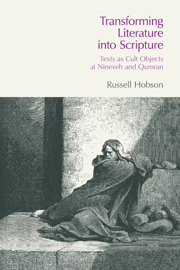Book contents
- Frontmatter
- Contents
- Acknowledgements
- Abbreviations
- 1 Authoritative Texts in the Hebrew and Cuneiform Traditions
- 2 Formulating a New Comparative Approach
- 3 Choosing the Right Texts
- 4 Study One: Enūma Anu Enlil Tablet 63
- 5 Study Two: Mul.Apin
- 6 Study Three: The Laws of Hammurabi
- 7 Study Four: Tablet XI of the Epic of Gilgamesh
- 8 Study Five: Mīs Pî
- 9 Study Six: Manuscripts of Pentateuchal Texts from Near the Dead Sea
- 10 Interpreting the Evidence
- Notes
- Bibliography
- Index of Ancient References
- Index of Authors
- Index of Subjects
7 - Study Four: Tablet XI of the Epic of Gilgamesh
- Frontmatter
- Contents
- Acknowledgements
- Abbreviations
- 1 Authoritative Texts in the Hebrew and Cuneiform Traditions
- 2 Formulating a New Comparative Approach
- 3 Choosing the Right Texts
- 4 Study One: Enūma Anu Enlil Tablet 63
- 5 Study Two: Mul.Apin
- 6 Study Three: The Laws of Hammurabi
- 7 Study Four: Tablet XI of the Epic of Gilgamesh
- 8 Study Five: Mīs Pî
- 9 Study Six: Manuscripts of Pentateuchal Texts from Near the Dead Sea
- 10 Interpreting the Evidence
- Notes
- Bibliography
- Index of Ancient References
- Index of Authors
- Index of Subjects
Summary
The Text
The Epic of Gilgamesh gained immediate popularity in modern times after it was first published by George Smith in 1872 as an ancient Babylonian parallel to Genesis 1–11. Later scholarship has determined that the text now known as the Epic of Gilgamesh is based on a collection of earlier Sumerian literary works based around a common hero, which date to the late third or early second millennium bce. The early Akkadian versions of the Gilgamesh poems, extant from around the nineteenth century bce, were apparently based on their Sumerian antecedents, but subsequent editing and transmission of the poems transplanted the hero Gilgamesh into some literary compositions not known in the earlier versions. It is in this way that tablet XI, containing the story of the Deluge originally know from the Atraḫasis poem, was included in what became the standard Babylonian version of the Epic.
The Manuscripts
The fragments of tablet XI in the standard Babylonian series examined here are from Neo-Assyrian and Neo-Babylonian sources. There are eight manuscripts represented by the fragments, which were excavated from Nineveh, Ashur, Nimrud, and Babylonia, and two further manuscripts that hold only the incipit of our text. The following list and description of the manuscripts relies on the full treatment of the sources in A. R. George's critical edition. The sigla used by A. R. George are also employed in the present analysis.
- Type
- Chapter
- Information
- Transforming Literature into ScriptureTexts as Cult Objects at Ninevah and Qumran, pp. 75 - 88Publisher: Acumen PublishingPrint publication year: 2012



